|
Note: I wrote this back in 1999.
The Princetoad started its life in 1963, as a Fender Princeton-Amp. I had been debating the ethics of amp restoration/modification with a good friend, Doug Harrison (aka The Amazing Celibate Dude). In fact, it was His Celibacy that started me on my mania for old Fender amps. 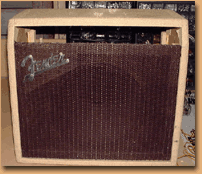 I already had a reverence for anything old (especially electronics), so this was just a natural progression. I already had a reverence for anything old (especially electronics), so this was just a natural progression. First I had to decide what I wanted to do - did I want to build an amp from scratch, or restore an original amp, or what? My first preference was to build a tube amp from scratch - that way I could say I did it all, from the ground up (and if I screwed it up and destroyed a perfectly good vintage amp, Doug would never let me hear the end of it). I ran into two problems: a) while there are numerous resources for old tube amp parts, both new and used, obtaining a replacement chassis for a vintage Fender amp is near impossible, unless you want a tweed-style chassis (square chrome boxes are easy to make - brown & black face chassis are not). b) It was extremely cost prohibitive - assuming I wanted to build a tweed-style amp (I didn't), the chassis & cabinet alone would have cost more than a vintage amp. Well, I wasn't about to buy a vintage amplifier and destroy it. However, if I could find an amp that someone else had butchered first, I had no qualms about finishing the job. So I set out to find a vintage amp that had been modified to the point that it no longer held any value to collectors, and strip it down to the two main components, the chassis and cabinet. After a couple weeks of searching, I found it: a 1963 brownface Fender Princeton amp (chassis), transplanted into a custom made cabinet.  The cabinet itself was identical to the original in every way but one - it was 1" taller (this was obviously done to accomodate a 12" speaker). It had been covered in blonde tolex, with oxblood grill cloth, and someone had taken a flat metal Fender logo off a larger brown-era amp and screwed it onto the baffle. The chassis was in ok shape - two of the pots were broken, and the paint on the faceplate was a little ugly, but that was it. The electronics didn't appear to have any major modifications, just a few replaced capacitors & resistors. One pleasant surprise was the speaker - a 60's Jensen P12R - a classic vintage speaker, worth almost as much as I paid for the amp ($300). I checked out the transformers, and since they both appeared to be in pretty good shape I decided to reuse them as well (again, a significant savings, considering what transformers cost). Overall, I think I did pretty well; I got the chassis, cabinet, speaker & transformers for $300, vs. the cost of buying the same parts new - chassis=$130, cabinet=$300, speaker=$110, transformers=$140 - the total for buying all new parts comes out to $680, not including all the electronic components, etc.
So I had the basic building blocks for my amp. What next? Well, it needed guts & skin. I figured, no problem, there's a million vendors on the web for this stuff. Well, it turns out that is the problem - there are so many vendors calling all the parts so many different things that my initial feeling of slight confusion was multiplied by a factor of 10. The cabinet itself was identical to the original in every way but one - it was 1" taller (this was obviously done to accomodate a 12" speaker). It had been covered in blonde tolex, with oxblood grill cloth, and someone had taken a flat metal Fender logo off a larger brown-era amp and screwed it onto the baffle. The chassis was in ok shape - two of the pots were broken, and the paint on the faceplate was a little ugly, but that was it. The electronics didn't appear to have any major modifications, just a few replaced capacitors & resistors. One pleasant surprise was the speaker - a 60's Jensen P12R - a classic vintage speaker, worth almost as much as I paid for the amp ($300). I checked out the transformers, and since they both appeared to be in pretty good shape I decided to reuse them as well (again, a significant savings, considering what transformers cost). Overall, I think I did pretty well; I got the chassis, cabinet, speaker & transformers for $300, vs. the cost of buying the same parts new - chassis=$130, cabinet=$300, speaker=$110, transformers=$140 - the total for buying all new parts comes out to $680, not including all the electronic components, etc.
So I had the basic building blocks for my amp. What next? Well, it needed guts & skin. I figured, no problem, there's a million vendors on the web for this stuff. Well, it turns out that is the problem - there are so many vendors calling all the parts so many different things that my initial feeling of slight confusion was multiplied by a factor of 10. 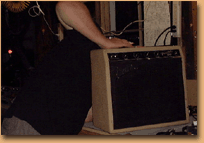 Also, no one had everything I needed - I'll admit that I've become spoiled living in Silicon Valley - regardless, I felt it was important to find one vendor who could help me with all of my problems, regardless of whether I walked in, called them, or sent them a letter. There's a saying up here - "You know you live in Silicon Valley when you stop asking how much will it cost, and you start asking how long will it take". Mea culpa, I am guilty of this behavior, but not because I have an excess of cash. I appreciate a bargain as much as the next person, but I will ALWAYS pay more for good service (and it just happens to turn out that good service is normally very quick). Also, no one had everything I needed - I'll admit that I've become spoiled living in Silicon Valley - regardless, I felt it was important to find one vendor who could help me with all of my problems, regardless of whether I walked in, called them, or sent them a letter. There's a saying up here - "You know you live in Silicon Valley when you stop asking how much will it cost, and you start asking how long will it take". Mea culpa, I am guilty of this behavior, but not because I have an excess of cash. I appreciate a bargain as much as the next person, but I will ALWAYS pay more for good service (and it just happens to turn out that good service is normally very quick).Anyway, after sending out about 6 emails to vendors I was considering buying from, and recieving no response for a week (the only one that had a reasonable excuse was Rodgers Amplifiers - a hurricane had destroyed their shop, so they were forgiven :), I finally took a look at Torres Engineering's website. I had seen it before, but I hadn't realized they were in San Mateo, just 20 minutes from Mountain View. When I called them, Dan answered the phone and I immediately got a good vibe. I ended up driving there that afternoon, and it was instantly glad I did - it was obvious that these guys knew exactly what they were doing (Dan Torres is actually very well known, but I didn't know this at the time). The first words out of my mouth were the complete truth - "I need all the electronics for a brown Princeton, but I have no idea what they are". Dan just smiled and said "then let's get out the schematic". About an hour later I walked out a little 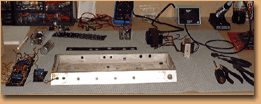 poorer in the monetary sense, but far richer in knowledge about tube amp construction. I had seen the schematic for this particular amp before, but I was unsure of alot of the values - allow me to explain. Capacitors and resistors are rated at certain values - everyone knows that. All you have to do is find the schematic symbol, and the adjacent number designates the value for that particular component. Sounds simple, right? Wrong - on the old Fender schematics, it just gives you a number. The number without the appropriate unit of measure (microfarad, picofarad, etc.) is worthless, unless you understand the circuit well enough to know what each components is for, in which case you probably don't need the schematic. When I questioned Dan about this, his reply was "you just have to know". Wonderful. Here's the complete list of the components I purchased: poorer in the monetary sense, but far richer in knowledge about tube amp construction. I had seen the schematic for this particular amp before, but I was unsure of alot of the values - allow me to explain. Capacitors and resistors are rated at certain values - everyone knows that. All you have to do is find the schematic symbol, and the adjacent number designates the value for that particular component. Sounds simple, right? Wrong - on the old Fender schematics, it just gives you a number. The number without the appropriate unit of measure (microfarad, picofarad, etc.) is worthless, unless you understand the circuit well enough to know what each components is for, in which case you probably don't need the schematic. When I questioned Dan about this, his reply was "you just have to know". Wonderful. Here's the complete list of the components I purchased:
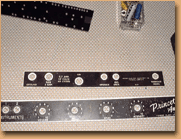 It was pretty grungy, so it took a while to get it clean. This amp wasn't sitting in an attic for 36 years, this amp was played. When it was clean, I did the same thing with the front & rear faceplates, but instead of the ammonia (I have no idea how ammonia reacts with paint, and I really didn't want to find out), I used a mild dishwashing detergent & a little bit of water. It was pretty grungy, so it took a while to get it clean. This amp wasn't sitting in an attic for 36 years, this amp was played. When it was clean, I did the same thing with the front & rear faceplates, but instead of the ammonia (I have no idea how ammonia reacts with paint, and I really didn't want to find out), I used a mild dishwashing detergent & a little bit of water. After everything was clean, it was time to wire up the circuit board. It looked pretty easy - there just isn't that much too it. The thing I found difficult was getting a good solder joint. The circuit board I used was a replica of an original Fender - unfortunately, Torres' didn't have any made specifically for the brown Princeton, so I bought a board that was pre-drilled for a tweed Bassman - most of the holes were in the (approximate) right place, so I only had to drill about 3 or 4 more. Each hole had a small metal grommet inserted into it to provide an anchor for the solder joints. The only good way to get a good solder joint is to insert every component end into the hole at the same time, and try to get them to stay in place long enough for the solder to bond to the grommet. The phrase "pain in the ass" was uttered many times during this procedure. It took about 3 hours for me to wire up the circuit board (I made sure to solder any connecting wires to the board at the same time). I didn't know this at the time, but I had bent the resistor wires too close to the resistor core, and basically killed them - well, I didn't kill them, but they definitely changed values. After I finished the main circuit board I wired up the smaller circuit board for the bias control. I forgot to buy one of these, so I made one from the backing board of the original circuit board (all the while congratulating myself for buying extra grommets). When that was all finished I started to put the amp together. 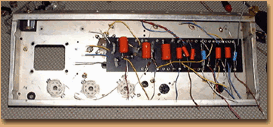 I started off with the lamp assembly - it's in a wierd place, and it's a little difficult to get the nut tightened properly. Next I installed the tube sockets. I had originally bought "replacement Fender tube sockets", but it turns out that they didn't fit the holes in the vintage chassis. I returned them to Torres' shop and got some slightly smaller ceramic sockets instead (actually, I was happier this way - the ceramics used machine screws & nuts, so I could attach tube clips to them). Next came all the assorted front and rear mounted components - switches, jacks, fuse assembly, & pots. Once those were installed I mounted the transformers, and finally the circuit board(s).
Once everything was mounted, I started wiring the
I started off with the lamp assembly - it's in a wierd place, and it's a little difficult to get the nut tightened properly. Next I installed the tube sockets. I had originally bought "replacement Fender tube sockets", but it turns out that they didn't fit the holes in the vintage chassis. I returned them to Torres' shop and got some slightly smaller ceramic sockets instead (actually, I was happier this way - the ceramics used machine screws & nuts, so I could attach tube clips to them). Next came all the assorted front and rear mounted components - switches, jacks, fuse assembly, & pots. Once those were installed I mounted the transformers, and finally the circuit board(s).
Once everything was mounted, I started wiring the
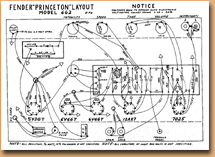 components together. It took me 5 minutes to come to the conclusion that the original schematic just wasn't going to work. I had an 8 1/2"x11", poor quality reproduction of the original black & white line drawing - not the sort of thing that people with (already) poor eyesight need to be staring at for hours. It seemed to me that the best guide (for me, anyway) would be a multi-color graphic representation of the physical layout of the amp, that I could (preferably) zoom in on if I so desired.
components together. It took me 5 minutes to come to the conclusion that the original schematic just wasn't going to work. I had an 8 1/2"x11", poor quality reproduction of the original black & white line drawing - not the sort of thing that people with (already) poor eyesight need to be staring at for hours. It seemed to me that the best guide (for me, anyway) would be a multi-color graphic representation of the physical layout of the amp, that I could (preferably) zoom in on if I so desired.With that in mind I went in and sat down at the computer, opened up a couple different drawing programs & started experimenting. I tried Photoshop, Illustrator, Visio, Corel, but in the end I chose the most unlikely of programs - Microsoft Powerpoint 97. I had only used Powerpoint once or twice before (for work),  but there were a couple of functions that seemed to be tailor made for my needs. I went through the original schematic, verified the circuit paths, etc., and made a modern version (you can find it in our amplifiers section, under schematics). It took about 4 hours, but when I was finished, I was happy I took the time to do it right. (Side note: for those of you who care, my diagram differs from the original in only one place - the original shows the brown & blue wires coming from the output transormer going to pins 3 on the two 6V6 tubes - this is the correct configuration, but the original diagram has them wired out of phase. My diagram corrects this.)
but there were a couple of functions that seemed to be tailor made for my needs. I went through the original schematic, verified the circuit paths, etc., and made a modern version (you can find it in our amplifiers section, under schematics). It took about 4 hours, but when I was finished, I was happy I took the time to do it right. (Side note: for those of you who care, my diagram differs from the original in only one place - the original shows the brown & blue wires coming from the output transormer going to pins 3 on the two 6V6 tubes - this is the correct configuration, but the original diagram has them wired out of phase. My diagram corrects this.)With my new diagram in hand (actually, I just carried my laptop out to the garage and put it on the workbench) I started wiring everything together. This went very quickly, since I wasn't struggling to read the old schematic. 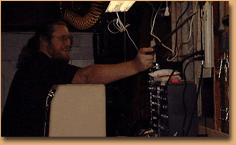 It took about 3 hours to complete, only because I double & triple checked each connection - I really didn't want to blow anything up because I was careless. When I was finally sure that I did everything right, I wired up the new power cord (I replaced the original with a 3-prong cord), re-installed the chassis in the cabinet, and plugged it in. I'll admit I was nervous about what was going to happen - I was pretty sure it would work, but there was just a little bit of aprehension that I couldn't completely squelch. I was nervous enough that I stood WAY back from the amp, and I used a really long screwdriver to flip the switch on the power strip. Yes, I felt like a doofus, but I comforted myself with the knowledge that there was no possible way I was going to get shocked.
Well, it didn't work. The light came on, but that was it. No sound, no hum, no nothing. The tubes didn't even light up, which really worried me. My wife just laughed at me and went back inside the house, leaving me with my shame. Now that's love. It took about 3 hours to complete, only because I double & triple checked each connection - I really didn't want to blow anything up because I was careless. When I was finally sure that I did everything right, I wired up the new power cord (I replaced the original with a 3-prong cord), re-installed the chassis in the cabinet, and plugged it in. I'll admit I was nervous about what was going to happen - I was pretty sure it would work, but there was just a little bit of aprehension that I couldn't completely squelch. I was nervous enough that I stood WAY back from the amp, and I used a really long screwdriver to flip the switch on the power strip. Yes, I felt like a doofus, but I comforted myself with the knowledge that there was no possible way I was going to get shocked.
Well, it didn't work. The light came on, but that was it. No sound, no hum, no nothing. The tubes didn't even light up, which really worried me. My wife just laughed at me and went back inside the house, leaving me with my shame. Now that's love.I opened the amp back up and started to check every single connection. 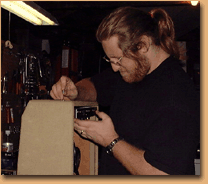 I numbered every single solder point and went through them systematically. Within about 10 minutes I had found 3 mistakes, one of which was so severe that I had a hard time believing that I actually did it (I had wired what would normally be power-in to the power tubes straight to ground - that's why the tubes didn't light up. doh!). So I fixed the mistakes I could find, went and got the wife to watch (and to whack me with a 2x4 if I suddenly got really stiff), and turned it back on. Nothing happened right away - the tubes had to warm up - but when they did, I got a surprise. It made sound - the most awful screetching sound I had ever heard come from an amp (and I once saw Queensryche in concert - purely by accident, I assure you - so I know what I'm talking about). This time the wife wasn't laughing, she just hightailed it into the house. But I was elated. I knew that if it made that much noise, the power section had to be functioning properly. I was a little unsure about the preamp section, but I was pretty sure it was functioning correctly. I assumed that the problem was the bias. Setting the bias on a tube amp is another one of those things that people tell you to do, but no one can accurately describe how to do it. I understood the principle behind it, but I didn't know how to perform the operation. I spent about another hour going over all my connections, and finally concluded that I had done everything correctly, and the amp was functioning correctly, but the bias was not set correctly, and I was better off leaving this part to a professional (and watching to see what he did.) I numbered every single solder point and went through them systematically. Within about 10 minutes I had found 3 mistakes, one of which was so severe that I had a hard time believing that I actually did it (I had wired what would normally be power-in to the power tubes straight to ground - that's why the tubes didn't light up. doh!). So I fixed the mistakes I could find, went and got the wife to watch (and to whack me with a 2x4 if I suddenly got really stiff), and turned it back on. Nothing happened right away - the tubes had to warm up - but when they did, I got a surprise. It made sound - the most awful screetching sound I had ever heard come from an amp (and I once saw Queensryche in concert - purely by accident, I assure you - so I know what I'm talking about). This time the wife wasn't laughing, she just hightailed it into the house. But I was elated. I knew that if it made that much noise, the power section had to be functioning properly. I was a little unsure about the preamp section, but I was pretty sure it was functioning correctly. I assumed that the problem was the bias. Setting the bias on a tube amp is another one of those things that people tell you to do, but no one can accurately describe how to do it. I understood the principle behind it, but I didn't know how to perform the operation. I spent about another hour going over all my connections, and finally concluded that I had done everything correctly, and the amp was functioning correctly, but the bias was not set correctly, and I was better off leaving this part to a professional (and watching to see what he did.)So the next day I took the completed chassis up to Torres' shop and asked him to troubleshoot it. I came back a few days later, and Dan had just finished working on it. When I asked him what was wrong with it, he said "lots". Har har. I asked him to elaborate, and he said that most of the problems were with bad solder joints - these would not prevent the amp from working, but they would eventually pop off because the solder had not bonded to the metal grommets properly.  Another problem was with some of the resistors - I had bent the wire too close to the resistor core, and that changed some of the values. He explained that the newer resistors were more forgiving, but I should be careful not to bend the wires so close next time. And I was right about the bias - it needed to bet set, so he took care of that (this bummed me out, because I wanted to watch him do it - oh well). But those things weren't keeping the amp from working - even with the bad solder joints, wrong resistor values and wrong bias. What was preventing the amp from working (and also causing the screetching noise) was that the output transformer wires were wired out of phase. I was very happy about this, because I knew I had done it correctly, and that meant the schematic was wrong. I told Dan this, and he said "bull", and I said "get out the schematic". So we did, and it turns out that I was right! Woohoo!
Needless to say, I felt pretty good. I had a working amp that I had built from scratch (for the most part), with a minimum of outside help. Plus it sounded really good... I only use NOS RCA tubes in my vintage amps (it's the only thing that I'm snobbishly adamant about), but Dan had suggested a Sovtek 12AX7 for a preamp replacement. I declined, stating my principles in no uncertain terms, until he said "trust me". Well, it was only $9, so I figured what the hell, I'll try a Russkie tube. It sounded pretty good, until you put it side by side with an NOS preamp tube.... sorry, but on this one Dan gets low marks. It is a very high gain tube - so high, in fact, that it sounds like a mini-Marshall when you turn it up to e-leven. So I switched it out - I like my Fenders to sound like Fenders - I prefer the smoother breakup that I get from the RCA's. Another problem was with some of the resistors - I had bent the wire too close to the resistor core, and that changed some of the values. He explained that the newer resistors were more forgiving, but I should be careful not to bend the wires so close next time. And I was right about the bias - it needed to bet set, so he took care of that (this bummed me out, because I wanted to watch him do it - oh well). But those things weren't keeping the amp from working - even with the bad solder joints, wrong resistor values and wrong bias. What was preventing the amp from working (and also causing the screetching noise) was that the output transformer wires were wired out of phase. I was very happy about this, because I knew I had done it correctly, and that meant the schematic was wrong. I told Dan this, and he said "bull", and I said "get out the schematic". So we did, and it turns out that I was right! Woohoo!
Needless to say, I felt pretty good. I had a working amp that I had built from scratch (for the most part), with a minimum of outside help. Plus it sounded really good... I only use NOS RCA tubes in my vintage amps (it's the only thing that I'm snobbishly adamant about), but Dan had suggested a Sovtek 12AX7 for a preamp replacement. I declined, stating my principles in no uncertain terms, until he said "trust me". Well, it was only $9, so I figured what the hell, I'll try a Russkie tube. It sounded pretty good, until you put it side by side with an NOS preamp tube.... sorry, but on this one Dan gets low marks. It is a very high gain tube - so high, in fact, that it sounds like a mini-Marshall when you turn it up to e-leven. So I switched it out - I like my Fenders to sound like Fenders - I prefer the smoother breakup that I get from the RCA's.
Electronically the amp was finished. Cosmetically, it was a candidate for reconstructive surgery. The tolex was a horrible blonde, dirty & ripped, so that had to go. I hopped online and ordered some new brown tolex - after I got it I noticed it was the pinkish brown - not my first choice, but it would have to do. I stopped off at Home Depot and bought 2 cans of 3M spray adhesive, and went home & got to work. The only really hard part was getting the old stuff off. That took a couple hours, but once it was all off, the measuring, cutting, and application of the new tolex only took about 1.5 hours. I also replaced the handle, the feet, and the grill cloth. All in all, it's a fine amp - classic Fender sound, plenty of bottom end, it's the perfect gigging amp. Total time for the restoration was 2 weeks..... and behold! The completed amp cometh! 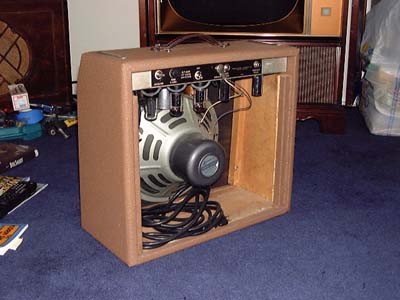 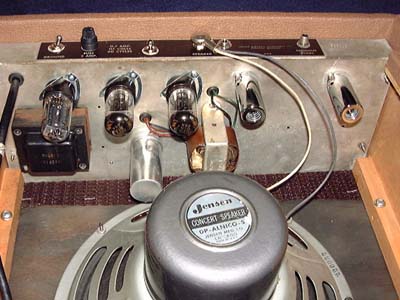 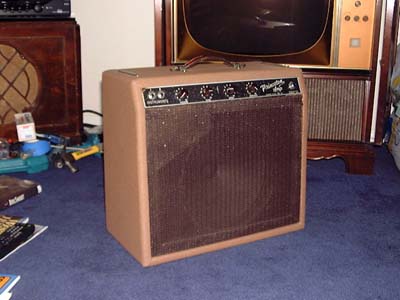 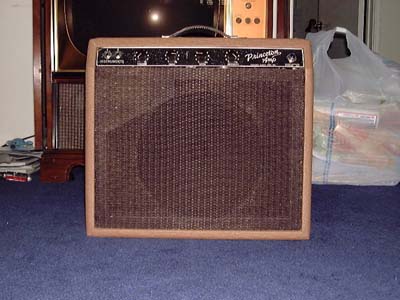 |

COOL VIDEO COOL PEOPLE COOL GEAR COOL PROJECTS |

|
|||
|
|||

|
All Images and content Copyright © 2015 TEN Effects
Artist images Copyright © the respective owners. All images obtained via public domain. If an image has been used in error, please contact us at correction@TENeffects.com |
|
|
